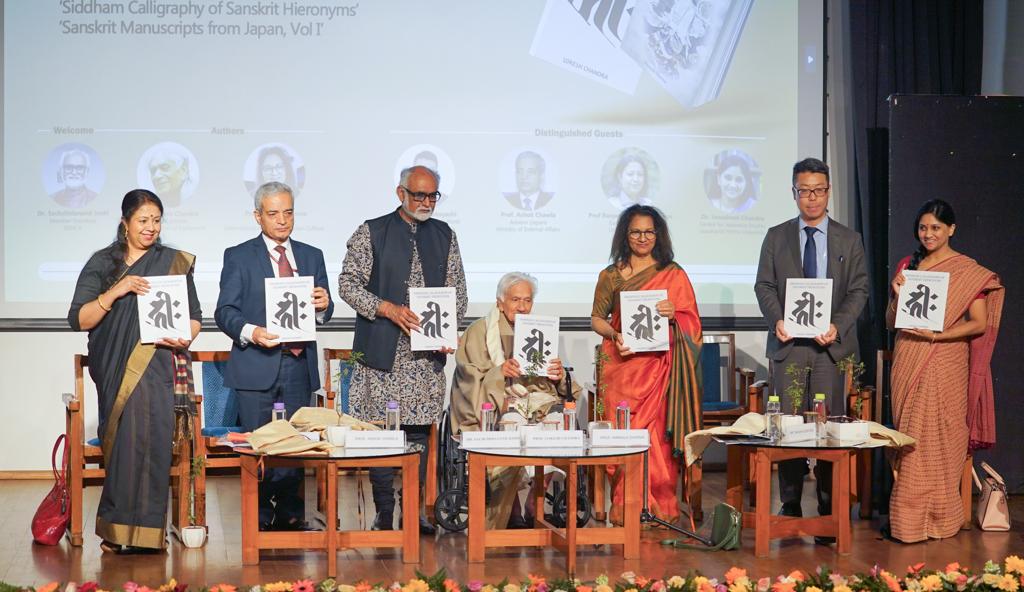
New Delhi: Indira Gandhi National Centre for the Arts (IGNCA) released two significant literary works, namely, ‘Siddham Calligraphy of Sanskrit Hieronyms’ and ‘Sanskrit Manuscripts from Japan, Vol I’ that aims to deepen our understanding of a rich cultural relations between India and Japan.
‘Siddham Calligraphy of Sanskrit Hieronyms’ is authored by Prof. Lokesh Chandra and ‘Sanskrit Manuscripts from Japan, Vol I’ is authored by Prof. Nirmala Sharma. The books were released by Sachchidanand Joshi, Member Secretary, IGNCA; Ashok Chawla, Advisor (Japan), Ministry of External Affairs; Ranjana Mukhopadhyay, University of Delhi; Takashi Kobayashi, First Secretary (PR & Culture), Japanese Embassy; and Janashruti Chandra, JNU. Both the authors were also present at the occasion. Venerable Khambo Lama of Mangolia was also present at the release function.
The first book has been authored by Lokesh Chandra, an eminent scholar of Buddhism. The book offers a comprehensive exploration of the history and evolution of Siddham calligraphy. This not only delves into the artistic intricacies of Siddham calligraphy but also illuminates its cultural significance in facilitating the exchange between India and Japan. It discusses calligraphic styles, characteristics of Zen calligraphy, various dharinis, the calligram of Prajnakirti of Kashmir, and the culmination of Siddham calligraphy in its spontaneity and rapture by Kobo Daishi. The release of this book also marks a euphoric celebration of the scholarly journey of Lokesh Chandra whose unparalleled contribution to the academic world continues even at the age of 98.
The second book, ‘Sanskrit Manuscripts from Japan, Vol. 1’, authored by Nirmala Sharma, marks the beginning of a ground-breaking series featuring facsimile editions of Sanskrit manuscripts from Japan. It showcases thirty-two meticulously reproduced facsimiles from the esteemed collection of the Kokiji Monastery. Prof. Sharma’s meticulous curation allows readers to delve into the rich repository of Sanskrit manuscripts, thereby facilitating a deeper appreciation of Japan’s invaluable contribution to the preservation of Sanskrit literature.
Speaking at the occasion, Lokesh Chandra, the author of the first book said that Calligraphy is the heart of the nation. Siddham is a divine script and a living dynamism of the Mantrayana way of Dharma in Japan. The first constitution of Japan (A.D. 604) was consecrated by a Sanskrit manuscript of the Usnisa-Vijay-Dharini, written in an earlier form of Siddham.
Nirmala Sharma expressed her happiness and said that the book, ‘Sanskrit Manuscripts from Japan, Vol 1’ is a result of extensive research and labour. She shared her experience of how the fascicules of the manuscripts had been gathered from the famous Kokiji monastery in Japan. She also remembered Jiun Sonja of Japan, a saint of the 18th century and his remarkable contributions in the collection of manuscripts.
Buddhism became an integral part of Japanese culture. It plays a pivotal role in cementing our relations with Japan. And when we try to foster this relationship, no one other than Lokesh Chandra emerges before us. The two books will lead us in the exploration of our deep-rooted cultural relations with Japan, said Sachchidanand Joshi, Member Secretary, IGNCA.
Ashok Chawla emphasised both the books, which we see today, is an outcome of cumulative knowledge, gathered and matured over decades of hard work. Both works are very significant, which will open the vista of deeper research in finding more linkages between India and Japan.
Ranjana Mukhopadyaya expressed her joy and pleasure to see the books having immense potentiality. She spoke about the close relations between India and Japan. How Buddhism travelled there and left an indelible imprint.
The two books will certainly redefine the relations between India and Japan. Both the countries are well-connected through Buddhism. Both the books provide a comprehensive history of our age-old connections, said Mr. Takashi Kobayashi.
Janashruti Chandra shed light on some unique peculiarities of the books. She said that both the books are well-researched and provide clues to researchers, scholars working in the field. The National Education Policy also outlines modules on Zen and Calligraphy to which the two books would prove beneficial for faculty as well as students.
These two books promise to deepen our understanding of the profound cultural connections between India and Japan, leaving an indelible mark on their cultural relations.
